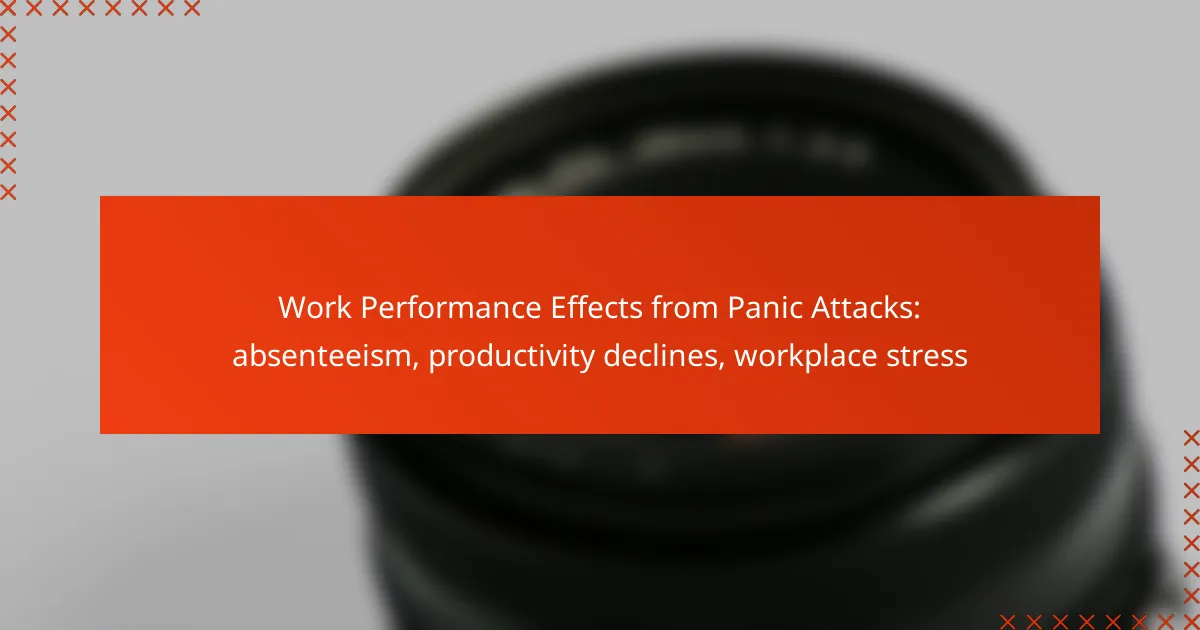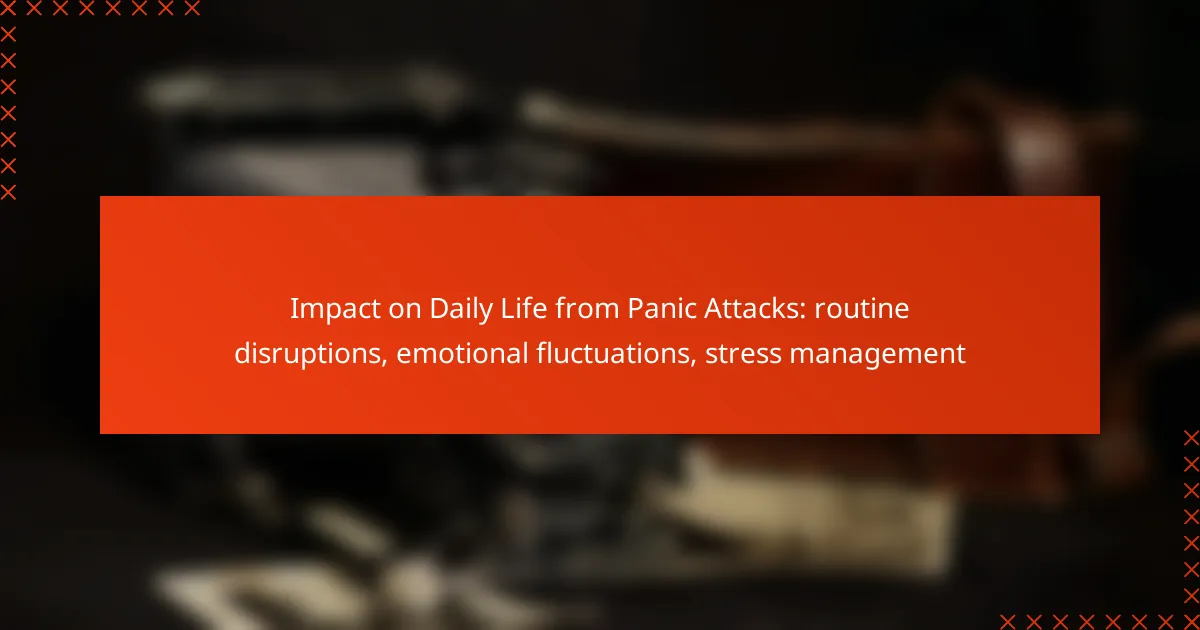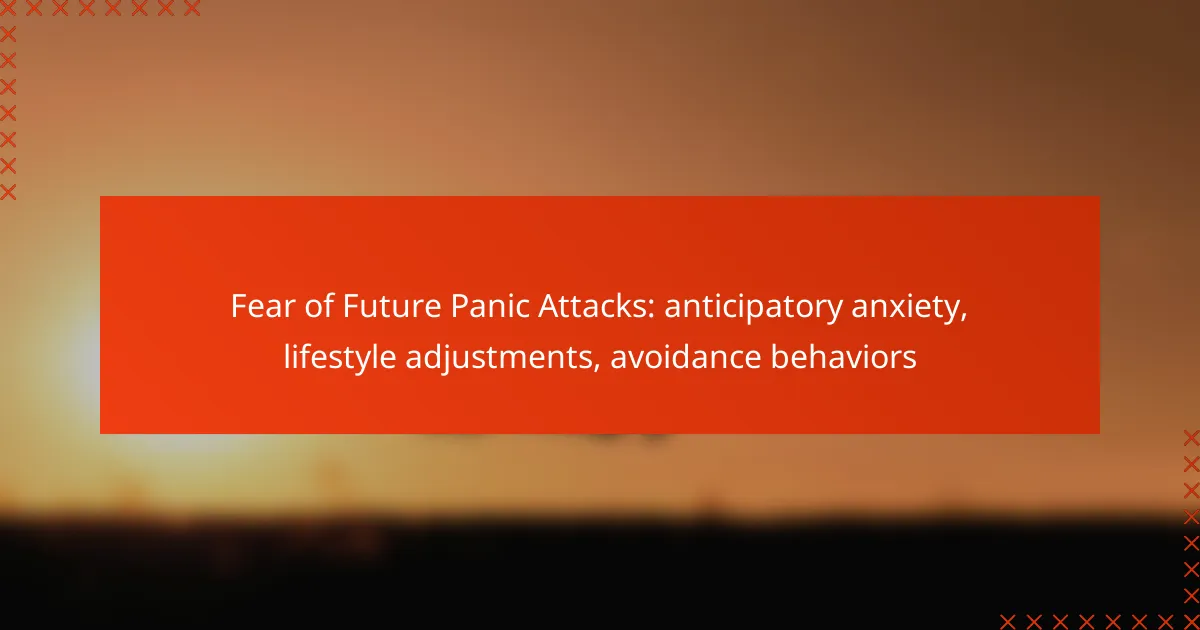Panic attacks can profoundly affect work performance, leading to increased absenteeism and diminished productivity. Employees may miss work due to the debilitating fear and anxiety associated with these episodes, creating a cycle of stress that further impacts their ability to perform. Additionally, heightened workplace stress can exacerbate panic attacks, resulting in a challenging environment that hampers both individual and organizational success.
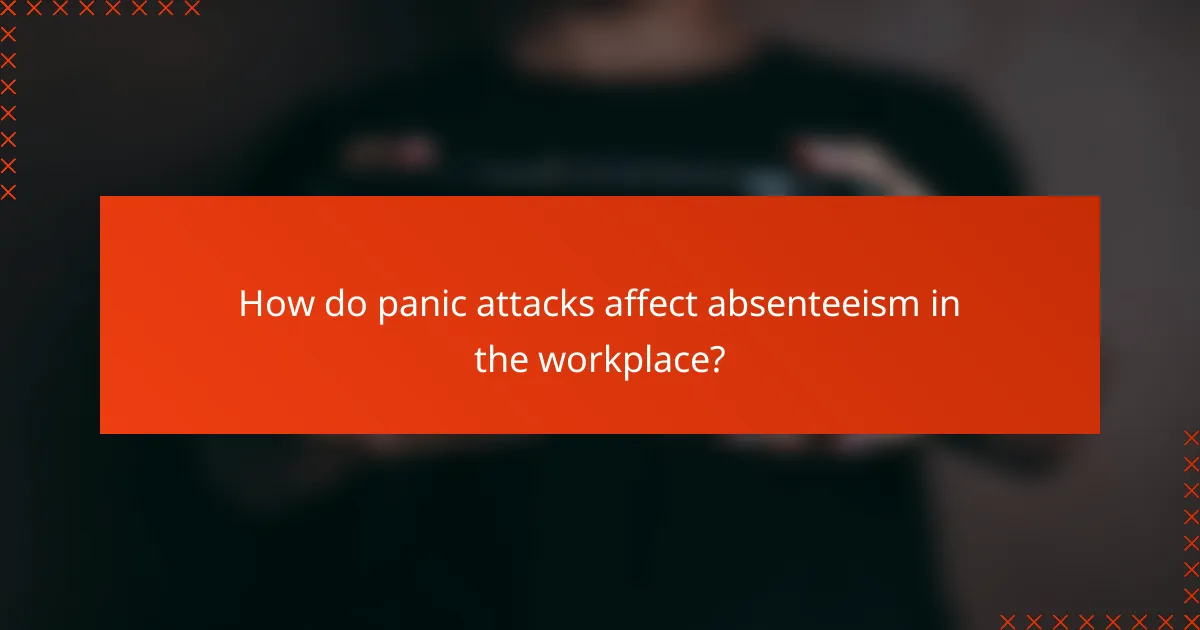
How do panic attacks affect absenteeism in the workplace?
Panic attacks can significantly increase absenteeism in the workplace by causing employees to miss work due to fear, anxiety, or physical symptoms. This can lead to a cycle of stress and further absenteeism, impacting overall productivity and workplace morale.
Increased sick leave
Employees experiencing panic attacks may frequently take sick leave to manage their mental health. This can result in extended periods away from work, as individuals may need time to recover from the debilitating effects of anxiety. Organizations may observe a pattern of sporadic absences, which can disrupt team dynamics and project timelines.
To mitigate this issue, employers should consider implementing mental health resources and flexible work arrangements. Providing access to counseling services or wellness programs can help employees manage their conditions and reduce the need for sick leave.
Higher turnover rates
Panic attacks can lead to higher turnover rates as employees may feel overwhelmed and unable to cope with workplace stress. When individuals do not receive adequate support, they may choose to leave their jobs in search of a more accommodating environment. This can create additional costs for organizations in terms of recruitment and training new staff.
Employers can address this by fostering a supportive workplace culture that prioritizes mental health. Regular check-ins, employee assistance programs, and training for managers on recognizing mental health issues can help retain staff and reduce turnover.

What is the impact of panic attacks on productivity?
Panic attacks can significantly hinder productivity by causing absenteeism and reducing the quality of work. Employees experiencing these episodes may struggle to focus, leading to decreased performance and increased workplace stress.
Reduced work output
Panic attacks can lead to reduced work output as affected individuals may miss workdays or be unable to perform at their best during episodes. This can manifest as lower-quality work, missed deadlines, and an overall decline in team efficiency.
For example, an employee who frequently experiences panic attacks might take several days off each month, resulting in a noticeable gap in their contributions. Over time, this can affect project timelines and team dynamics, leading to frustration among colleagues.
Lower employee engagement
Employees suffering from panic attacks often exhibit lower engagement levels, as the fear and anxiety associated with these episodes can make it difficult to participate fully in workplace activities. This disengagement can lead to a lack of motivation and connection with the team.
When employees are not fully engaged, they may miss opportunities for collaboration or fail to contribute ideas during meetings. Organizations may notice a decline in overall morale, as team members feel the impact of their colleague’s struggles on group performance.

How can workplace stress exacerbate panic attacks?
Workplace stress can significantly worsen panic attacks by increasing anxiety levels and creating an environment where individuals feel overwhelmed. High demands and insufficient coping resources can trigger or intensify these episodes, leading to absenteeism and decreased productivity.
High-pressure environments
High-pressure environments, such as those with tight deadlines or aggressive targets, can elevate stress levels, making panic attacks more likely. Employees may feel constant pressure to perform, which can lead to feelings of inadequacy and anxiety. This cycle can result in a decline in overall work performance and increased absenteeism.
To mitigate these effects, organizations should promote a balanced workload and encourage open communication about stressors. Regular check-ins and realistic goal-setting can help employees manage their responsibilities without feeling overwhelmed.
Lack of support systems
A lack of support systems in the workplace can exacerbate panic attacks by leaving employees feeling isolated and unsupported. When individuals do not have access to mental health resources or supportive colleagues, they may struggle to cope with stress effectively. This isolation can lead to increased anxiety and a higher likelihood of panic episodes.
Employers should foster a supportive culture by providing access to mental health resources, such as counseling services or stress management workshops. Encouraging peer support and creating a safe space for discussing mental health can also help employees feel more connected and less anxious.
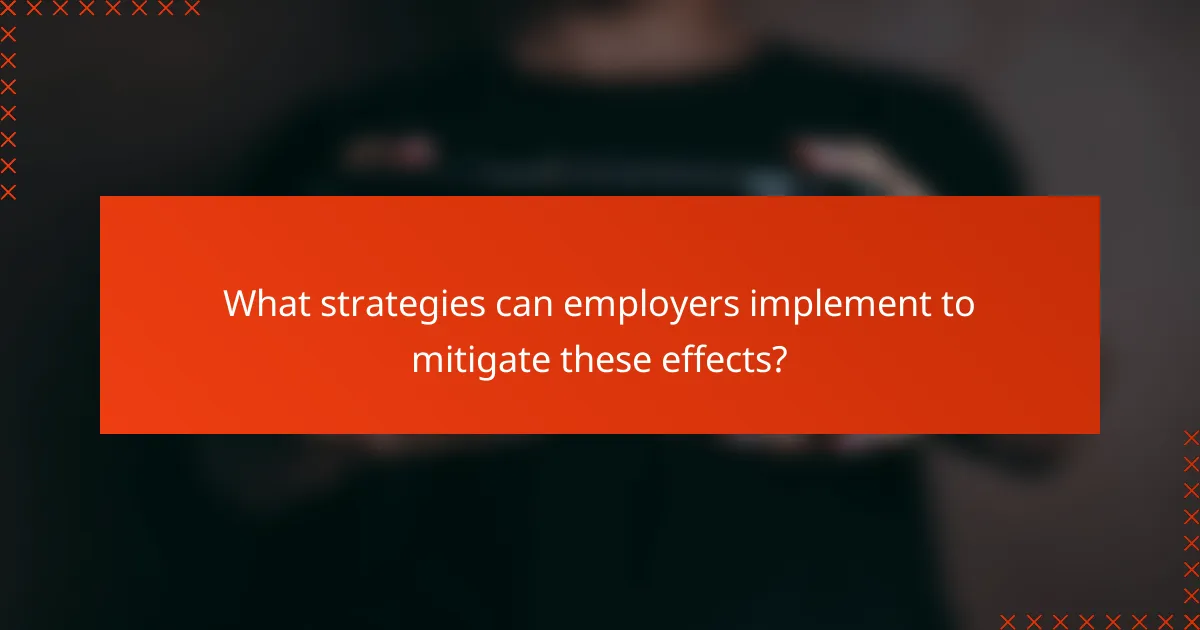
What strategies can employers implement to mitigate these effects?
Employers can implement several strategies to reduce the negative impacts of panic attacks on work performance, including enhancing support systems and creating flexible work environments. These strategies can help improve employee well-being and overall productivity.
Employee assistance programs
Employee assistance programs (EAPs) provide confidential support services to help employees manage personal issues, including mental health challenges like panic attacks. These programs often include counseling, stress management workshops, and resources for coping strategies.
Employers should promote EAPs actively and ensure that employees are aware of the available resources. Regular training sessions can help destigmatize mental health discussions and encourage employees to seek help when needed.
Flexible work arrangements
Flexible work arrangements, such as remote work options or adjustable hours, can significantly alleviate stress for employees experiencing panic attacks. Allowing employees to choose their work environment can lead to increased comfort and productivity.
Employers should consider implementing policies that support flexible schedules, such as core hours where employees must be available but allowing them to manage their time outside of those hours. This approach can help employees balance their work responsibilities with their mental health needs.

How can individuals manage panic attacks at work?
Individuals can manage panic attacks at work by employing strategies that promote calmness and focus. Techniques such as mindfulness and breathing exercises can significantly reduce anxiety and improve overall work performance.
Mindfulness techniques
Mindfulness techniques involve being present and fully engaged in the moment, which can help alleviate the symptoms of panic attacks. Practicing mindfulness can include activities like meditation, focusing on sensory experiences, or simply taking a moment to observe your surroundings.
To implement mindfulness at work, consider setting aside a few minutes each day for meditation or deep reflection. You can also integrate mindfulness into daily tasks by concentrating on the sensations of typing or the sounds around you, which can help ground you during stressful moments.
Breathing exercises
Breathing exercises are effective in managing panic attacks by promoting relaxation and reducing physical symptoms of anxiety. Techniques such as deep breathing or the 4-7-8 method can help lower heart rate and calm the mind.
To practice deep breathing, inhale slowly through your nose for a count of four, hold for a count of seven, and exhale through your mouth for a count of eight. Repeat this cycle several times. Incorporating these exercises into your routine can provide quick relief during stressful situations at work.

What role does mental health training play in the workplace?
Mental health training in the workplace is essential for fostering a supportive environment that enhances employee well-being and productivity. It equips staff with the knowledge and skills to recognize mental health issues, including panic attacks, and to respond effectively, thereby reducing absenteeism and improving overall performance.
Awareness and education
Awareness and education are crucial components of mental health training. By providing employees with information about mental health conditions, organizations can help them identify symptoms in themselves and their colleagues. This understanding can lead to earlier intervention and support, which can significantly reduce the impact of issues like panic attacks on work performance.
Training programs often include workshops, seminars, and resources that cover topics such as stress management, coping strategies, and the importance of seeking help. For example, a company might implement regular training sessions that focus on recognizing the signs of anxiety and panic disorders, promoting a culture of openness and support.
Reducing stigma
Reducing stigma surrounding mental health is a vital aspect of creating a healthy workplace. When employees feel comfortable discussing their mental health challenges without fear of judgment, they are more likely to seek help and support. Mental health training can play a significant role in changing perceptions and attitudes about mental health issues.
Organizations can implement initiatives such as mental health awareness campaigns and peer support programs to foster a more inclusive environment. Encouraging open conversations about mental health can help normalize these discussions, making it easier for employees to address their concerns and seek assistance when needed.
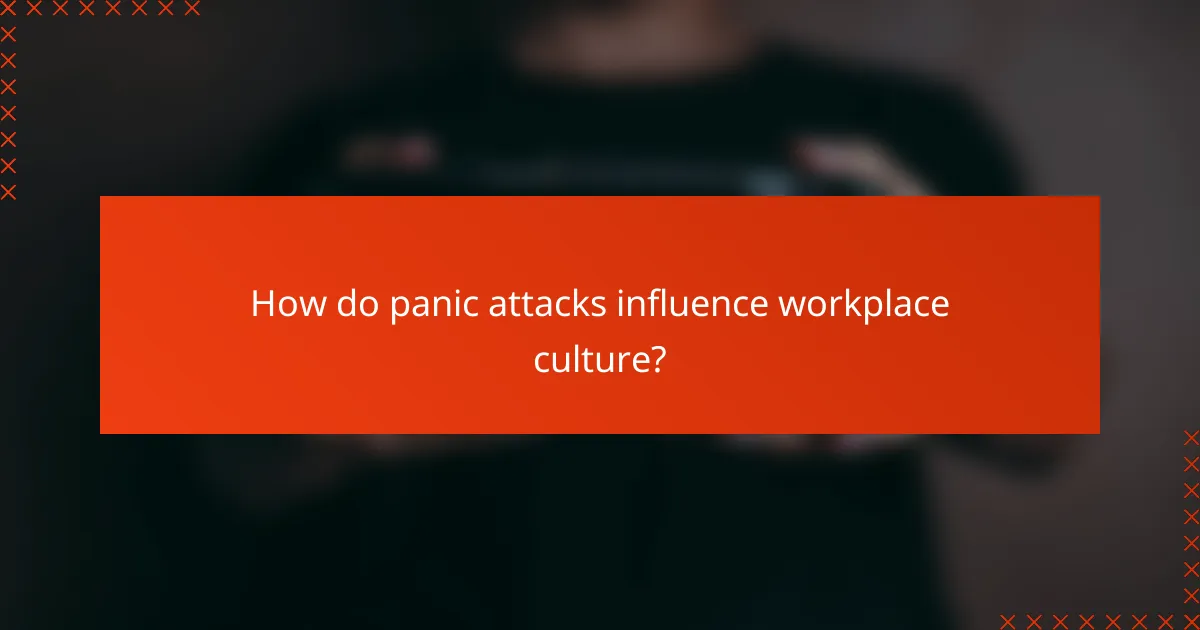
How do panic attacks influence workplace culture?
Panic attacks can significantly disrupt workplace culture by affecting employee interactions and overall productivity. When individuals experience panic attacks, it can lead to absenteeism and reduced engagement, creating a ripple effect on team performance and morale.
Impact on team dynamics
Panic attacks can create tension within teams, as colleagues may feel uncertain about how to support affected individuals. This uncertainty can lead to communication breakdowns and decreased collaboration, which are essential for a cohesive work environment.
Moreover, frequent absenteeism due to panic attacks can result in uneven workloads, causing frustration among team members. To mitigate these issues, fostering an open dialogue about mental health can help normalize discussions around panic attacks and encourage supportive behaviors.
Effects on morale
The presence of panic attacks in the workplace can lower overall morale, as employees may feel anxious about their own mental health or that of their colleagues. A culture that lacks understanding and support for mental health can lead to feelings of isolation and stress among employees.
Employers can enhance morale by implementing mental health resources, such as counseling services or stress management workshops. Recognizing and addressing the impact of panic attacks can create a more supportive atmosphere, ultimately benefiting the entire organization.

What are the long-term consequences of untreated panic attacks?
Untreated panic attacks can lead to significant long-term consequences, including chronic absenteeism from work, declines in productivity, and increased workplace stress. These effects can create a cycle that exacerbates mental health issues and impacts overall job performance.
Chronic mental health issues
Chronic mental health issues often arise from untreated panic attacks, leading to conditions such as generalized anxiety disorder or depression. These disorders can further impair an individual’s ability to function effectively in the workplace, resulting in a diminished quality of life.
Employees experiencing chronic mental health issues may find it challenging to concentrate, make decisions, or interact with colleagues. This can lead to increased absenteeism, as individuals may take more sick days to cope with their mental health struggles.
To mitigate these risks, it is essential for employers to foster a supportive work environment. Providing access to mental health resources, such as counseling services or stress management workshops, can help employees manage their conditions and improve overall workplace morale.
